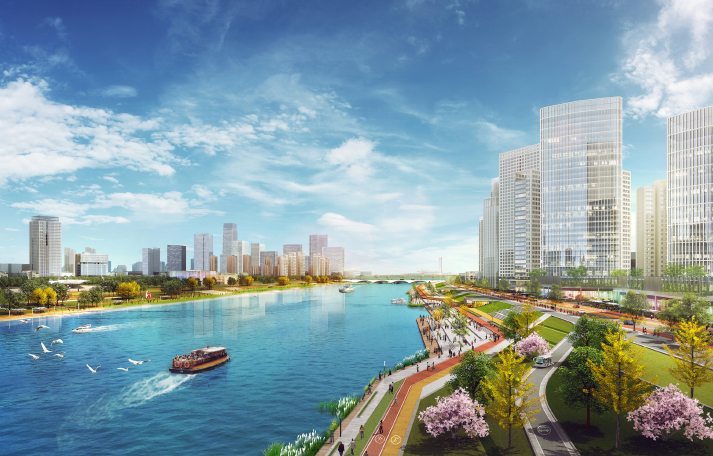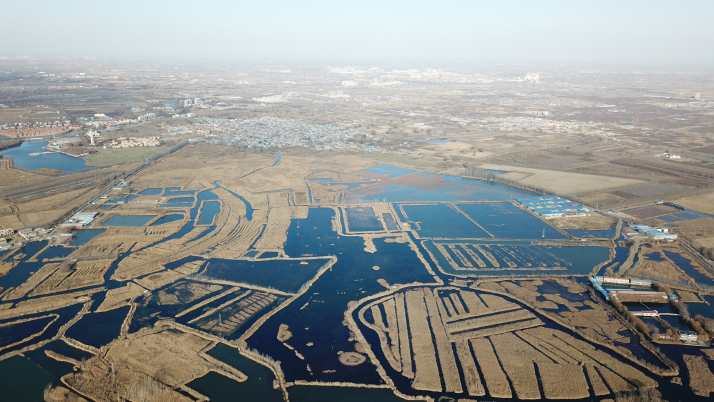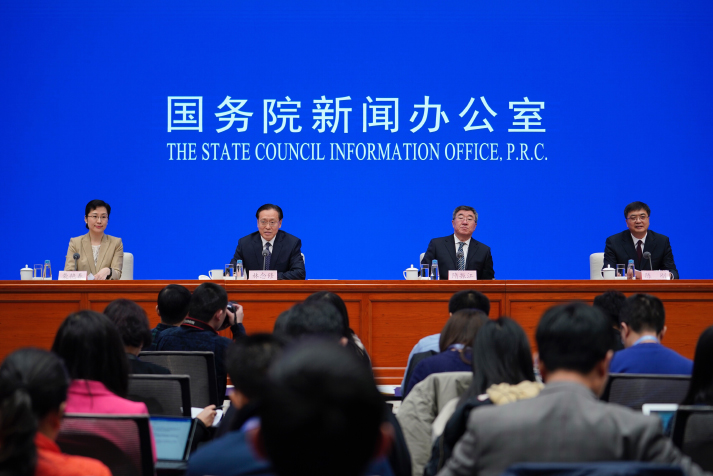|
||||||
|
||||||
| Home Nation World Business Opinion Lifestyle China Focus ChinAfrica Multimedia Columnists Documents Special Reports |
|
||||||
|
||||||
| Home Nation World Business Opinion Lifestyle China Focus ChinAfrica Multimedia Columnists Documents Special Reports |
| Nation |
| Beijing's Two Wings |
| The plan to make the megacity more of a pure capital takes shape |
| By Yuan Yuan · 2019-01-18 · Source: NO. 4 JANUARY 24, 2019 |
 The design draft of the sub-administrative center of Beijing in Tongzhou District is released for public opinion on June 21, 2018 (XINHUA)
On January 11, a flag-raising ceremony was held in front of the new office building of the Beijing Municipal Government in Tongzhou District in east Beijing. After being in the very center of Beijing's downtown area for 70 years, the government body moved to its new home about 30 km away from its former site. It is not the first municipal department to move to Tongzhou. In November 2018, quite a few others, including the Beijing Poverty Relief Office, started working in the new office buildings. After being selected as the sub-administrative center of Beijing, Tongzhou became the center of attention, with the mission to relocate the administrative functions of Beijing and relieve the traffic congestion and overburdened population in the downtown area.
The office buildings of the sub-administrative center of Beijing in Tongzhou District on September 16, 2016 (VCG)
A big move The work to relocate the administrative functions of Beijing has been in progress for years. In June 2012, at the 11th Beijing Municipal Congress of the Communist Party of China (CPC), Tongzhou was proposed as the sub-administrative center of Beijing for the first time. In the 2013 and 2014 Beijing government work reports, it was included as one of the major tasks of the city, clearly calling for the speeding up of the construction of the subsidiary center. In late November 2015, the Eighth Plenary Session of the 11th CPC Beijing Municipal Committee announced that all, or part, of Beijing's administrative departments were to be moved to Tongzhou in organized steps. The construction of the new administrative center started on December 30, 2015, and was basically completed in late 2017. To date, 35 municipal government departments and 165 agencies, with about 120,000 employees, have relocated their offices to Lucheng Town in Tongzhou. According to the plan, a total of about 400,000 employees from Beijing municipal government departments will eventually move to the new location. Zhao Le, an employee of the municipal government, told China Newsweek that his office was moved on December 23, 2018. "The parking lot in the new site is much more spacious than in the former site, and the traffic in Tongzhou is much less," Zhao said. He also recounted that the office move was arranged to be carried out after 9 p.m. to avoid causing daytime traffic congestion in downtown Beijing. Another government employee told Xinhua News Agency that it now takes him half an hour to drive to work from his home on the East Third Ring Road, shorter than before since the traffic in downtown is always heavy at peak hours. New local infrastructure and residential facilities have kept pace with the move. For commuters taking public transportation, there is a subway line linking the subsidiary administrative zone to the city center of Beijing, and a number of bus line services plying the area. A series of subway routes running across the center of Tongzhou are in the pipeline.  An aerial view of the Baiyangdian Lake on December 7, 2018 (XINHUA)
Haojiafu Village, where the sub-administrative center's official buildings are located, has experienced profound changes since the construction broke ground at the end of 2015. It used to be a village with about 10,000 residents. Now, with more government departments moving in, it has become one of the most bustling parts of the sub-administrative center. The area around Tongzhou Beiguan Station on subway Line 6 will be the new home for some businesses transferred from the financial and central business district in downtown Beijing, with four major landmark buildings under construction. Beijing School, a public school designed to offer 12 years of education through high school, began construction in August 2018 in Lucheng, an important step in the construction of bigger educational facilities in the area. The elementary section of the school is projected to be completed in July and start enrollment in September. Health officials at the legislative and political advisory sessions of Tongzhou reported that construction plans for four hospital or hospital expansion projects will be completed in 2019, with another five projects ready to start construction. Seven industrial clusters, each worth several hundred billion yuan will be built in Tongzhou by 2025. The industrial clusters will involve intelligent manufacturing, cultural tourism, cutting-edge chip-making and IT software. Environmental protection will be a top priority of the new sub-administrative center, said Sui Zhenjiang, Vice Mayor of Beijing, at a press conference of the State Council Information Office on January 11. "Historical and cultural protection, especially of the historical sites in Lucheng Town, Tongzhou District, is another major task of the sub-administrative center," Sui said. A giant chemical plant will be restructured into an 11-square-km forest park with a theater, library and museum as supplemental facilities. As an important gathering hub for the Jinghang Grand Canal, which is the longest, largest and one of the oldest canals in the world, Tongzhou has a rich historical and cultural heritage, which is coming more to life with the relocation. The Grand Canal Forest Park is now home to the annual Strawberry Music Festival and the Ice and Snow Festival. The Taihu Stage Art Center, built by the National Center for the Performing Arts in Taihu Town in Tongzhou, was put into official operation in September 2018. Located in Taihu Town in Tongzhou, it is the world's largest stage art center specializing in productions, rehearsals, set designs, stage art exchanges and warehousing. The Songzhuang Art Community, also located in Tongzhou, is the most famous and biggest artist community in Beijing with more than 2,000 artists in residence. It will also be an art and cultural center for the new sub-administrative center. In addition, Universal Studios Theme Park, which is under construction in an area 5 km from Taihu, is scheduled to be completed in 2020. On January 3, the CPC Central Committee and the State Council approved the plan for the sub-administrative center's development for 2016-35, stating that the sub-administrative center will not develop real estate projects on a large scale and the market will play a decisive role in resource allocation. According to the plan, the sub-administrative center, covering 155 square km, will extend to the whole area of the current Tongzhou District, which is 906 square km, accommodating 1.3 million permanent residents by 2035.
Tourists at the Grand Canal Forest Park on October 27, 2018 (XINHUA)
A big coordinated plan On January 16, President Xi Jinping paid an inspection visit to Xiongan New Area, in the Baoding area of north China's Hebei Province. The main function of this new area is to serve as a development hub for the Beijing-Tianjin-Hebei economic triangle. This is Xi's second visit to Xiongan, where he was informed of the construction progress and talked with local people. The Beijing Municipal Government move is big, but the relocation that is going to take place from Beijing to Xiongan will be much larger and will involve a greater distance. Both moves are part of the Beijing-Tianjin-Hebei integrated development plan, which has been progressing for five years. Xiongan was announced as a new area in April 2017. Rising from vast farmlands spanning Xiongxian, Anxin and Rongcheng counties, about 100 km southwest of Beijing, Xiongan was born to relocate many of Beijing's non-capital functions. It will embrace universities, research institutes, medical institutions, corporate headquarters, as well as financial and public institutions from Beijing. According to the 2018-35 master plan for Xiongan New Area officially approved on January 2, by 2035, Xiongan will basically develop into a modern city that is green, intelligent and livable, with relatively strong competitiveness and harmonious human-nature interaction. Lin Nianxiu, Vice Minister of the National Development and Reform Commission, said at a press conference on January 11, that Xiongan has fully shifted its focus from the design to the construction stage of the project. He compared Tongzhou and Xiongan to two wings of Beijing, adding that the construction of the two wings will focus on creating a friendly, ecologically healthy environment. "Some of our measures focus on building world-leading zones for people's work and life styles," Lin said. Xiongan New Area will control the use of land by eventually developing up to 30 percent of its area, leaving the rest for green space and water landscape, according to the master plan. Like the canal in Tongzhou, the Baiyangdian Lake in Xiongan New Area will be the highlight for eco-friendly construction. Procedures will be developed to replenish the lake's water and recover acreage that has been lost over the years. Rural pollution will be effectively constrained to ensure that the lake's water quality meets national standards. Vice Governor of Hebei Chen Gang said the lake will gradually be restored to 360 square km through replenishment of its water. In addition, a national park around the Baiyangdian Lake is planned for the future. The boundary of urban development will be strictly regulated, protecting permanent farmlands and treating the lakes, ponds, forests, farmlands and grasslands as a whole ecosystem. By the end of June 2017, the number of permanent residents in the area was about 1 million, with the design meant to accommodate 2-2.5 million people in the future. Hebei has also been active in attracting more talent for the development of Xiongan by recruiting new employees for government departments and units. A growing number of young people are also exploring opportunities in the area.  A press conference on the construction of Beijing's sub-administrative center and Xiongan New Area is held at the State Council Information Office on January 11 (XINHUA)
Liang Jing, 28, who works in a college in Beijing, is from Xiongxian County. "I believe with more people moving to Xiongan, there will be a great need for educational resources," Liang said. "I plan to go back to my hometown and start a training school." Zhang Ya never thought she would return to her hometown in Anxin County after leaving for college in 2008. The 29-year-old works as a media employee in Shijiazhuang, capital city of Hebei. "There weren't any cafés or bookstores in the county," she said. "If you wanted to go out, there were no places to go." The establishment of Xiongan New Area, however, made Zhang change her mind. Over the past year, she has frequently gone back to evaluate the possibility of running a café. "There will be a lot of young people swarming to Xiongan and the market potential is huge," Zhang said, revealing that she has already found business partners who are all from the three counties, but are currently working elsewhere. "Hopefully, our café can open this year," she said. Copyedited by Rebeca Toledo Comments to yuanyuan@bjreview.com |
About Us | Contact Us | Advertise with Us | Subscribe
|
||
| Copyright Beijing Review All rights reserved 京ICP备08005356号 京公网安备110102005860号 |